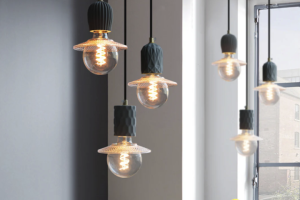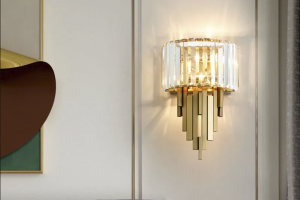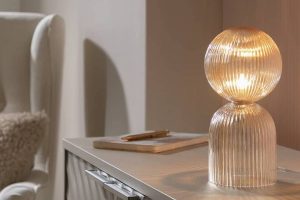Wall lighting refers to the use of light fixtures that are mounted on walls to provide illumination in a space. It is an essential element in interior design as it not only serves a functional purpose but also adds to the overall aesthetic appeal of a room. Wall lighting fixtures come in various styles, sizes, and designs, allowing homeowners to choose the perfect option that complements their space.
Benefits of Wall Lighting
1. Enhances the ambiance of a room: Wall lighting plays a crucial role in setting the mood and ambiance of a space. By strategically placing wall lights, you can create a warm and inviting atmosphere or a bright and energetic one, depending on the desired effect. The soft glow emitted by wall sconces or recessed lighting can create a cozy and intimate feel in a living room or bedroom, while track lighting can provide a more modern and vibrant look in a kitchen or dining area.
2. Provides task lighting: In addition to creating ambiance, wall lighting also serves as task lighting. It can be used to illuminate specific areas where focused lighting is needed, such as reading nooks, workspaces, or bathroom vanities. By installing swing arm lamps or picture lights, you can direct light exactly where it is needed, making tasks easier and more comfortable to perform.
3. Adds decorative features to a space: Wall lighting fixtures are not just functional; they also serve as decorative elements in a room. With countless designs and styles available, you can find wall lights that match your personal taste and complement the overall theme of your space. Whether you prefer sleek and modern sconces or ornate and vintage-inspired fixtures, wall lighting allows you to add personality and style to your home.
4. Saves space compared to floor lamps: One of the biggest advantages of wall lighting is that it saves valuable floor space. Unlike floor lamps or table lamps that require surface area, wall lights are mounted on walls, freeing up space for other furniture or decor. This is especially beneficial in smaller rooms or areas where space is limited. By utilizing wall lighting, you can maximize the functionality and aesthetics of your space without sacrificing valuable square footage.
Types of Wall Lighting Fixtures
1. Sconces: Wall sconces are one of the most popular types of wall lighting fixtures Niolta. They come in a variety of styles, from traditional to modern, and can be used in any room of the house. Sconces are typically mounted on walls at eye level and provide a soft and diffused light that adds warmth and ambiance to a space.
2. Picture lights: Picture lights are specifically designed to illuminate artwork or photographs on walls. They are typically installed above or below the artwork to highlight its details and create a focal point in the room. Picture lights come in various sizes and finishes, allowing you to choose the perfect option that complements your artwork and enhances its visual impact.
3. Swing arm lamps: Swing arm lamps are versatile wall lighting fixtures that can be adjusted to direct light exactly where it is needed. They are commonly used as reading lights in bedrooms or as task lighting in home offices or living rooms. Swing arm lamps are mounted on walls with an extendable arm that can be moved and positioned according to personal preference.
4. Recessed lighting: Recessed lighting, also known as can lights or downlights, is a popular choice for modern and minimalist spaces. These fixtures are installed into the ceiling or walls, creating a clean and seamless look. Recessed lighting provides a focused and directional light that is ideal for task lighting or highlighting specific areas in a room.
5. Track lighting: Track lighting consists of multiple light fixtures mounted on a track that can be adjusted and repositioned as needed. It is a versatile option that allows you to create different lighting effects by directing the light in various directions. Track lighting is commonly used in kitchens, dining areas, or living rooms where flexibility and adjustability are desired.
Choosing the Right Wall Lighting for Your Space
When selecting wall lighting for your space, there are several factors to consider to ensure that you choose the right fixture that meets your needs and complements your interior design.
1. Consider the purpose of the room: The first step in choosing wall lighting is to consider the purpose of the room. Different rooms have different lighting requirements, so it’s important to determine whether you need ambient lighting, task lighting, or accent lighting. For example, a living room may require a combination of ambient lighting and accent lighting to create a cozy and inviting atmosphere, while a bathroom may need bright and focused task lighting for grooming activities.
2. Determine the style of the space: The style of your space should also influence your choice of wall lighting fixtures. Consider the overall theme and decor of the room and choose fixtures that complement the existing design elements. For example, if you have a modern and minimalist living room, sleek and simple sconces or recessed lighting would be a suitable choice. On the other hand, if you have a traditional or vintage-inspired bedroom, ornate and decorative wall sconces would be more appropriate.
3. Choose the appropriate size and placement of the fixture: The size and placement of wall lighting fixtures are crucial in achieving the desired lighting effect. Consider the size of your room and the height of your walls when choosing the size of the fixture. A small sconce may get lost on a large wall, while an oversized fixture may overwhelm a small space. Additionally, consider the placement of the fixture to ensure that it provides adequate illumination without causing glare or shadows.
Wall Lighting for Different Rooms
1. Living room: In the living room, wall lighting can be used to create a warm and inviting atmosphere. Sconces or recessed lighting can be installed around the perimeter of the room to provide ambient lighting, while picture lights can be used to highlight artwork or photographs on the walls. Additionally, floor lamps or table lamps can be paired with wall lighting to create layered lighting and add depth to the space.
2. Bedroom: In the bedroom, wall lighting is essential for creating a cozy and relaxing environment. Bedside sconces or swing arm lamps can be installed on either side of the bed to provide task lighting for reading or other activities. Additionally, wall sconces or recessed lighting can be used to provide ambient lighting and create a soothing atmosphere.
3. Bathroom: In the bathroom, wall lighting is crucial for providing bright and focused task lighting for grooming activities. Vanity lights are commonly used above bathroom mirrors to eliminate shadows and provide even illumination for applying makeup or shaving. Additionally, recessed lighting can be installed in the ceiling or walls to provide ambient lighting and create a spa-like atmosphere.
4. Kitchen: In the kitchen, wall lighting is important for providing both task lighting and ambient lighting. Track lighting is a popular choice for kitchens as it allows you to direct light exactly where it is needed, such as over countertops or kitchen islands. Additionally, recessed lighting can be used to provide general illumination, while under-cabinet lights can be installed to illuminate workspaces.
5. Dining room: In the dining room, wall lighting is essential for creating a warm and inviting atmosphere during meals. Wall sconces or picture lights can be installed on either side of a buffet or sideboard to provide accent lighting and highlight decorative elements. Additionally, a chandelier or pendant light can be installed above the dining table as a focal point and to provide ambient lighting.
Wall Lighting for Ambience and Mood

1. Dimmer switches: Installing dimmer switches for your wall lighting fixtures allows you to adjust the brightness of the lights and create different moods and atmospheres in a room. Dimmers are particularly useful in living rooms, bedrooms, or dining areas where you may want to create a cozy and intimate ambiance.
2. Color temperature: The color temperature of the light emitted by your wall lighting fixtures can also affect the mood and atmosphere of a room. Warm white or soft white light (2700K-3000K) creates a cozy and inviting feel, while cool white or daylight (5000K-6500K) light creates a bright and energetic atmosphere. Consider the desired mood of your space when choosing the color temperature of your wall lighting.
3. Layering lighting: Layering lighting is an effective technique for creating depth and dimension in a room. By combining different types of wall lighting fixtures, such as sconces, recessed lighting, and picture lights, you can create layers of light that provide both functionality and aesthetics. For example, in a living room, you can use recessed lighting for general illumination, sconces for ambient lighting, and picture lights to highlight artwork or photographs.
Wall Lighting for Task Lighting
1. Reading lights: Wall-mounted swing arm lamps or sconces are ideal for providing task lighting for reading in bedrooms or living rooms. These fixtures can be adjusted to direct light exactly where it is needed, making reading more comfortable and enjoyable.
2. Vanity lights: In the bathroom, wall-mounted vanity lights are essential for providing bright and focused task lighting for grooming activities. These fixtures are typically installed above bathroom mirrors to eliminate shadows and provide even illumination for applying makeup or shaving.
3. Desk lamps: Wall-mounted desk lamps are a great option for home offices or workspaces where space is limited. These lamps can be mounted on walls above desks or workstations to provide focused task lighting without taking up valuable surface area.
Wall Lighting for Artwork and Decorative Features
1. Picture lights: Picture lights are specifically designed to illuminate artwork or photographs on walls. These fixtures are typically installed above or below the artwork to highlight its details and create a focal point in the room. Picture lights come in various sizes and finishes, allowing you to choose the perfect option that complements your artwork and enhances its visual impact.
2. Accent lighting: Wall lighting can be used to accentuate architectural features or decorative elements in a room. By installing wall sconces or recessed lighting near a fireplace, bookshelf, or alcove, you can draw attention to these areas and create visual interest.
3. Display lighting: Wall lighting can also be used to highlight and showcase collectibles or decorative objects. By installing wall-mounted spotlights or track lighting, you can create a gallery-like display and add drama and visual impact to your space.
Wall Lighting Installation Tips
1. Hire a professional electrician: When installing wall lighting fixtures, it is recommended to hire a professional electrician to ensure that the installation is done safely and correctly. They will have the necessary knowledge and expertise to handle electrical wiring and ensure that the fixtures are securely mounted.
2. Follow manufacturer instructions: Always follow the manufacturer’s instructions when installing wall lighting fixtures. Each fixture may have specific requirements and guidelines for installation, so it’s important to read and follow these instructions carefully.
3. Consider the weight of the fixture: Before installing wall lighting fixtures, consider the weight of the fixture and ensure that the wall can support it. Some fixtures may require additional support or reinforcement, especially if they are heavy or have multiple components.
Maintenance and Care for Wall Lighting Fixtures
1. Regular cleaning: To keep your wall lighting fixtures looking their best, it is important to clean them regularly. Dust and dirt can accumulate on the surface of the fixtures, affecting their appearance and performance. Use a soft cloth or duster to gently wipe the fixtures and remove any dust or debris.
2. Replacing bulbs: Over time, the bulbs in your wall lighting fixtures may need to be replaced. Follow the manufacturer’s instructions for replacing bulbs and ensure that you use the correct type and wattage. Regularly check the bulbs to ensure that they are functioning properly and replace any burnt-out bulbs promptly.
3. Checking for loose connections: Periodically check the connections of your wall lighting fixtures to ensure that they are secure and not loose. Loose connections can affect the performance of the fixtures and pose a safety hazard. If you notice any loose connections, tighten them or contact a professional electrician for assistance.
Wall lighting is an essential element in interior design, providing both functionality and aesthetics to a space. It enhances the ambiance of a room, provides task lighting, adds decorative features, and saves space compared to floor lamps. There are various types of wall lighting fixtures to choose from, including sconces, picture lights, swing arm lamps, recessed lighting, and track lighting. When selecting wall lighting for your space, consider the purpose of the room, determine the style of the space, and choose the appropriate size and placement of the fixture. Wall lighting can be used in different rooms of the house, such as the living room, bedroom, bathroom, kitchen, and dining room, to create the desired atmosphere and meet specific lighting needs. Whether you are looking to create ambiance and mood, provide task lighting, or highlight artwork and decorative features, wall lighting offers endless possibilities for enhancing your space.





More Posts
Creative Studio Essential: Industrial Gear Pendant
Vintage Industrial Bulb Chandelier for Loft Spaces
Enhance Your Space with a Luxe Crystal Wall Lamp